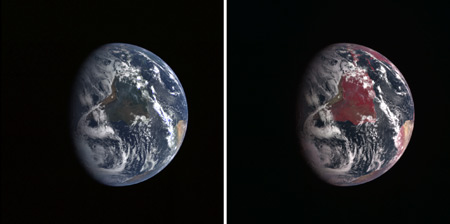The MESSENGER spacecraft is currently on its way to the innermost planet, Mercury. It launched in 2004, and will arrive at the tiny planet in 2011. Why so long? Mercury orbits the Sun very quickly, much faster than the Earth. Just getting there is hard enough, but if the spacecraft isn’t moving fast enough, Mercury will whiz right past it. So MESSENGER has to change it velocity by quite a bit (how much? Well, that’s a bit complicated * (hmmm, I’m having trouble getting the anchor linking to work. Scroll down to see the footnote)). There isn’t enough fuel on board to do it, so they borrow the velocities of Earth, Venus, and even Mercury itself to get the spacecraft moving rapidly enough to catch up to the mercurial (hahaha! ha!) planet.
When MESSENGER flew by the Earth in August of 2005, the engineers back home decided to test the cameras. They got the images above (click for a higher-res version). They’re lovely! The one on the left is a “true color” image, adding red, green, and blue filtered images. You can see South America there in the center. On the right is pretty much the same view, but instead of red light, they used blue-green-infrared. Vegetation reflects IR light very well, and so the Brazilian rainforest acts almost like a mirror in IR. It shows up as very red in this image. MESSENGER detected life on Earth from more than 100,000 kilometers away!
Well, not really. Lots of things reflect IR, but it’s still pretty cool. The cameras on board are pretty hi-res, so when it gets to Mercury the images will be spectacular.
Still, for nifty images we don’t have to wait that long (as the images above show). Later on I’ll post another cool thing MESSENGER did on that flyby of Earth…
* One problem is that Mercury’s orbit is elliptical, and so it changes its velocity around the Sun. At the nearest point in its orbit (perihelion) it moves about 60 kilometers/second. At the farthest point (aphelion) it’s only moving about 40 km/sec. For reference, the Earth moves about 30 km/sec. So how much velocity the spacecraft needs depends on when it gets to Mercury. It looks to me that orbital insertion occurs at Mercury perihelion, which strikes me as odd, since that means they need to add more velocity to the spacecraft for it to enter orbit. There must be some logical reason for it, of course. Emily, if you’re reading this… :-)’
